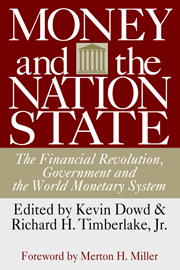The linchpin for Argentina’s economic reforms has been its currency board-like system, which was instituted on April 1, 1991. But even though the peso-dollar exchange rate has remained fixed at 1-to-1, there has often been speculation that the peso will be devalued. Consequently, there is still an interest rate spread between Argentine loans in pesos and dollars. During the past year the spread on 30-day loans varied between 50 and 440 basis points.
To make Argentina’s currency unification with the dollar perfect, Argentine President Carlos Saul Menem has suggested replacing the peso with the dollar. This official dollarization would eliminate the peso-dollar interest rate spreads. Lower interest rates could add as much as two percentage points to Argentina’s rate of growth and make it much less variable. Even if sharing seigniorage–what a central bank earns by issuing its own currency–with the U.S. could not be negotiated, the cost of forfeiting peso seigniorage (.2% to .25% of gross domestic product) would be much smaller than the gains from eliminating currency risk, reducing interest rates, and stimulating higher economic growth.
Dollarization is desirable. But what form should it take? The government of Argentina is considering at least two possibilities: unilateral dollarization, which can occur without a treaty with the U.S., and a limited treaty under which Argentina might regain some of the seigniorage it would lose from dollarization and gain access for Argentine banks to the discount window of the Federal Reserve System as a source of liquidity.
My own preference is for unilateral dollarization, now rather than later. It would bring down interest rates quickly and does not require the approval of the U.S. government or the involvement of the Fed.
Argentina would need about $15 billion to replace the peso monetary base with dollars–that is, to trade every one of Argentina’s pesos for dollars. This swap of currencies would be feasible because, in consequence of the Convertibility Law, the central bank’s liquid reserves are about $24 billion.
The second possibility, a limited treaty with the U.S. that would allow Argentine banks to have access to the Federal Reserve s discount window would be far from optimal. One reason is that, contrary to what most economists think, it is undesirable to have a central bank as a lender of last resort. All the most expensive rescues of banking systems have occurred under central banking. Argentina, in fact, holds the record for the most expensive bank rescue in proportion to the size of its economy: the banking crisis of 1980-82 cost 55% of GDP.
Argentina already has in place a liquidity fund of $6.7 billion. The key provision of the fund, which was established in December 1996, is the something called the Contingent Repurchase Facility. Under this program, the Argentine central bank has the option to sell certain domestic assets for dollars to a group of banks subject to a repurchase clause. As of October, 14 international banks were participating in the facility. The assets underlying the repurchase facility included $6.2 billion in Argentine U.S. dollar-denominated bonds and up to $500 million in dollar-denominated Argentine mortgages. Consequently, the facility can provide emergency liquidity, but is not a lender-of-last-resort arrangement which by its nature also provides the government with the power to inflate.
Combined with the extensive internationalization of Argentina’s banking system (which makes the international banks’ head offices, in effect, lenders of last resort to local branches) current arrangements for emergency liquidity are adequate for a dollarized system. Furthermore, dollarization does not prevent the government from being a lender of last resort: the government’s fiscal authorities can lend to banks directly. Direct lending by the government is likely to be more transparent than lending by a central bank.
Official dollarization would require the monetary base–peso notes and coins, plus peso deposits of financial institutions with the central bank–to be swapped into dollar assets. Dollarization can be started immediately and largely completed within 30 days. A schedule of 30 days is realistic; other countries have made more complex monetary reforms in less time.
The first step would be to ensure that the liquid reserves of the central bank are at least equal to the monetary base. Argentina meets this requirement.
The second step would be to announce that effective immediately the dollar would replace the peso as the unit of account; all peso wages, prices, assets, and liabilities would become dollar wages, prices, assets, and liabilities at the rate of one dollar to one peso. Because the exchange rate is 1-to-1, no transition period would be necessary. No commission fees would be permitted for converting values in pesos into their equivalents in dollars.
Bank deposits and loans bearing fixed interest rates would continue to bear the same interest rates until they expire, except the principal and interest would be payable in dollars. Interest rates in dollars would be lower than rates were in pesos just before dollarization. Borrowers would be able to benefit from lower interest rates if they can refinance their debts; if not, they would be no worse off than they would have been under the currency board-like system, because, in terms of dollars, they would be paying equivalent amounts at the same rates of interest as they were paying in pesos.
Dollarization would cause some redistribution of income: In general, new borrowers of dollars would pay less and lenders would earn less than they do now because they would be unable to lend in pesos. But lenders would enjoy some benefit because there would no longer be any possibility of a devaluation.
The government would also immediately replace peso deposits at the central bank with dollar assets. In 1995 Argentina already took a step in this direction 1y moving settlement of payments from peso accounts at the central bank to a dollar account at a bank in New York. This step would simply complete the process.
Peso notes and coins would then be retired from circulation; the bulk of them preferably should be retired during the transition period. How quickly that can be accomplished depends on how quickly’ the central bank can obtain dollar notes. Once retirement of peso notes begins, banks would not be allowed to charge commission fees for replacing them with dollars. Finally the government would need to reorganize the central bank to act only in regulating financial institutions and gathering financial statistics.
Some people may think that dollarization, if adopted, should only be temporary. But historical experience indicates that dollarization in the form I have proposed should be permanent. I propose to continue allowing Argentines to use any currency but to prevent the government from issuing a currency again. For Argentina, a country with a history of hyperinflation, government-issued currency has almost always been a curse.









